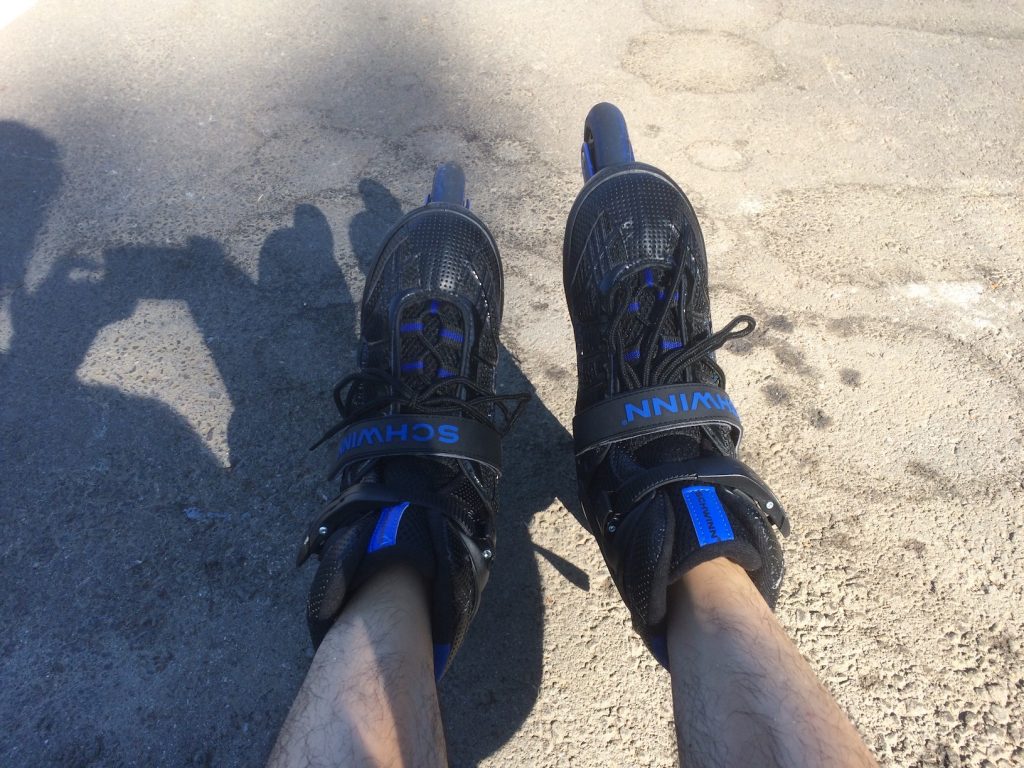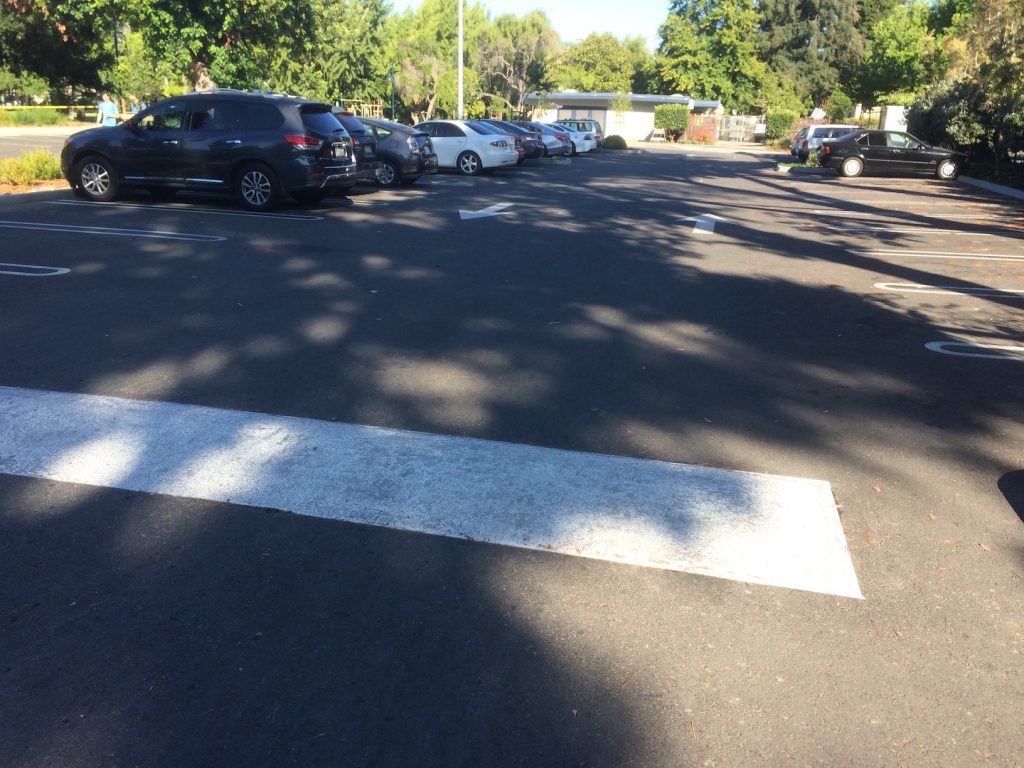I appreciate that the Bay Area has no seasons: I don’t have to shovel snow to get out the front door, and I don’t have to hide from mosquitos. However, no winter also means that no ice skating season, and after going a handful of times this past year, I was starting missed skating and wished that I could do it without ice.
I soon realized that you can skate without ice, and like all bad ideas, I asked myself, “How hard could it be?”

I wasn’t a complete idiot and did buy a full set of knee pads, elbow pads, and wrist guards. As one does in the internet age, I taught myself through YouTube videos and went for it. Over the next 3 months or so, I learned a few things.
Lesson 1: Terrain Matters
On my first day, I strapped on my safety gear and skates and stepped outside. I pushed off onto the cobblestone path and instantly regretted my decision.
While walking, biking, and driving outside, I vaguely notice the terrain. I know that some roads are rougher and some sidewalks are broken, but it really affect my movement. Shoes and rubber tires handle most bumps up to curbs pretty well.
As I rattled over the cobblestones, every little bump looked huge. Sidewalk gaps became chasms. Twigs and pebbles sent me windmilling to keep my balance. I realized then just how great the Zamboni is for creating smooth ice to skate on, and reflecting on it, even tiny grooves on skated-out rinks were terrible.
Lesson 2: It’s Not the Same
Speaking of ice skating, that was really my excuse for being so bold. When I told my mom that I was going to try rollerblading, she told me, “You know, you’re not that young anymore.” I basically ignored her because I know how to ice skate. I’m not great, but I know how to ice skate.
However, rollerblading didn’t feel anything like ice skating at first. While I was trying to skate around the park, I could imagine myself from the third-person gingerly stepping foot by foot. I looked just like all of those people I dodged at the the skating rink. I used to roll my eyes at them, but in that moment, I could completely relate.
Lesson 3: Learn to Fall
I have skied four times in my life and am there qualified to give expert ski instruction on the internet. The first thing in learning to ski is to fall over. Part of it is learning how to fall correctly, but I think it’s useful psychological. In skiing, skating, and just about all sports, you will fall (physically or metaphorically), and you can’t be afraid to do it. By accepting that you will fall, you will be more comfortable pushing yourself to the point where you can actually test your limits and improve.
By the end of my first day rollerblading, I had fallen exactly zero times. When I got home, I proudly told Julie that I had escaped unscathed, but it actually made me anxious. Every stride that I didn’t fall made me worry more about when the first time would be. I just needed to fall once, and I would feel better.
Don’t worry: it didn’t last long.
According to Dan on YouTube, the best way to stop is to jump and land sideways. It looks crazy: you’re going forward, and then suddenly you’re not. I tried it slowly a couple times standing still, then went for it.
And over the course of the next few skates, I managed to fall in all four directions. I fell forwards (on my right side) when I had too much momentum. I fell backwards (on my left side) when I overcorrected. I fell on my butt when I landed sideways and my skates slipped under me. I fell on my knees when I overcorrected for that.
I learned how to fall.
Lesson 4: Starting from Scratch can be good
When I took figure skating lessons as a kid, I learned how to do crossovers to turn. We would just skate around and around the face-off circles without a problem. As an adult, I honestly couldn’t remember how to do it. I watched a few YouTube videos, but I again was always scared to commit to it. I kept thinking I would catch the pick and eat ice.
Since rollerblading still felt different, I just let Dan taught me how to do a crossover from scratch. His teaching method was unlike anything I remembered, but in 30 seconds, I got it. I still turn better to the left than I do to the right, but by doing laps and laps, I can do it fluidly in both directions.
Most important, I feel really cool while I’m doing it.
Lesson 5: Send it
Dan said in his videos that it’s important to learn how to do tricks to become a better skater. I learned a few different ways to skate including the lemon and crossover lemon as well as a few ways to stop. However, the real cool trick is jumping, and not just jumping to stop: jumping to get over stuff.
Remembering lesson 1, terrain looks big, and I set a goal to jump on this speed hump.

Remembering lesson 2, I never learned how to jump anyways, and remembering lesson 3, I was ready to fall. I tried to just skate over the speed hump and almost fell, so I knew that if I didn’t clear it, I would fall, and it would probably be on my face. I had to commit.
Remembering lesson 4, Dan on YouTube taught me how to jump, and I practiced jumping for 2 weeks to increase my height and distance. Towards the end of that second week, I realized I could jump next to the speed hump (that I would usually skate around) to measure my jump.
I could, and it was time to go for it.
I wasn’t sure when I would feel ready, but on one lap, I felt it was right and positioned myself for the middle of the speed hump. I couldn’t chicken out and go around. I had to commit.
I measured my distance, bent my knees, swung my arms back, and jumped…
Clear over the speed hump. I thought it would be close, but I cleared it by a foot at least. I realized how few new skills I pick up these days because when I did that, I felt good, and I haven’t felt that in awhile.
Lesson 6: Know Your Limits
When I started, I thought it would be cool to commute on rollerblades rather than my bike. It’s not far, it would be better exercise, and I would enjoy it more. About half-way through my training, I was confident enough in my turning and braking to give it a shot.
And that is probably the last time I will ever do it.
It was hard. As rough as I thought the parking lot was, real roads are far rougher. The paving is less consistent, and there’s a lot more debris. Not only is that bumpier, but it’s also a lot more work (presumably from the friction).
And it was scary. I’m pretty used to biking around cars, but I’m mentally not ready to be rollerblading around them. I made it into the office, but I had Julie pick me up that evening because I’m not sure if I could do it again.
I know there are risks with all sports and transportation. I have had a few bike accidents, but I’m generally confident that I have enough control to bike safely for a long time.
When I think about rollerblading, however, I still accept and assume that I will fall. In a parking lot, I might get some road rash, but on the streets, it could be a lot worse. With rollerblading, injuries are not just an “if” but actually a “when.”
On that uplifting note, I haven’t been rollerblading for a week and a half, and I noticed myself feeling quite antsy this week. I think I miss it even as I can see the ceiling and risk in doing it. We will see if I can keep it up, at least until ice skating season.